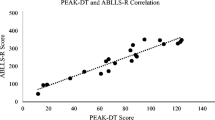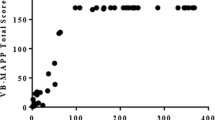Abstract
The present investigation sought to explore initial psychometric properties of the PEAK Relational Training System—Module 1: Direct Training for children with autism. Thirteen children diagnosed with autism or related disorders were exposed to an initial assessment designed to evaluate skill deficits within their repertoire, the Peabody Picture Vocabulary Test, and the Illinois Early Learning Standards Test. Additionally, staff performances were evaluated on reliability of delivery of the PEAK assessment. Results yielded significant positive correlations among the obtained PEAK assessment scores, the Peabody and the Standards assessments. Implications for evidence-based discrete trial training curricula are discussed.


Similar content being viewed by others
References
Anderson, S. R., Avery, D. L., DiPietro, E. K., Edwards, G. L., & Christian, W. P. (1987). Intensive home-based intervention with autistic children. Education and Treatment of Children, 10, 352–366.
Autism Speaks, Inc. (2013). Applied behavior analysis (ABA). Retrieved October 10, 2013 from http://www.autismspeaks.org/what-autism/treatment/applied-behavior-analysis-aba.
Dixon, M. R. (2014). The PEAK relational training system module 1: direct training. Carbondale: Shawnee Scientific Press.
Dunn, L. M., & Dunn, D. M. (2007). Peabody picture vocabulary test (4th ed.). San Antonio: Pearson.
Garcia, E., Baer, D. M., & Firestone, I. (1971). The development of generalized imitation within topographically determined boundaries. Journal of Applied Behavior Analysis, 4, 101–112.
Greer, R. D., Yaun, L., & Gautreaux, G. (2005). Novel dictation and intraverbal responses as a function of a multiple exemplar instructional history. The Analysis of Verbal Behavior, 21, 99–116.
Hayes, S. C., Barnes-Holmes, D., & Roche, B. (2001). Relational frame theory: A post-Skinnerian account of human language and cognition. New York: Kluwer Academic/Plenum.
Illinois State Board of Education. (2013). Illinois early learning and development standards. Retrieved October 10, 2013 from http://www.isbe.state.il.us/earlychi/pdf/early_learning_standards.pdf.
Lovaas, O. I. (1987). Behavioral treatment and normal education and intellectual functioning in young autistic children. Journal of Consulting and Clinical Psychology, 55, 3–9.
Luciano, C., Becerra, I. G., & Valverde, M. R. (2007). The role of multiple-exemplar training and naming in establishing derived equivalence in an infant. Journal of the Experimental Analysis of Behavior, 87, 349–365.
Partington, J. W. (2006). ABLLS-R: The assessment of basic language and learning skills- revised. Walnut Creek: Behavior Analysts, Inc.
Partington, J. W., Sundberg, M. L., Newhouse, L., & Spengler, S. M. (1994). Overcoming an autistic child’s failure to acquire a tact repertoire. Journal of Applied Behavior Analysis, 27, 733–734.
Sidman, M. (1971). Reading and auditory-visual equivalences. Journal of Speech and Hearing Research, 14, 5–13.
Skinner, B. F. (1957). Verbal behavior. New York: Appleton.
Sulzer-Azaroff, B., & Mayer, G. R. (1991). Behavior analysis for lasting change. Fort Worth: Holt, Rinehart, and Winston.
Sundberg, M. L. (2008). VB-MAPP: Verbal behavior milestones assessment and placement program. Concord: AVB Press.
Yamamoto, J., & Mochizuki, A. (1988). Acquisition and functional analysis of manding with autistic students. Journal of Applied Behavior Analysis, 21, 57–64.
Author information
Authors and Affiliations
Corresponding author
Rights and permissions
About this article
Cite this article
Dixon, M.R., Carman, J., Tyler, P.A. et al. PEAK Relational Training System for Children with Autism and Developmental Disabilities: Correlations with Peabody Picture Vocabulary Test and Assessment Reliability. J Dev Phys Disabil 26, 603–614 (2014). https://doi.org/10.1007/s10882-014-9384-2
Published:
Issue Date:
DOI: https://doi.org/10.1007/s10882-014-9384-2




